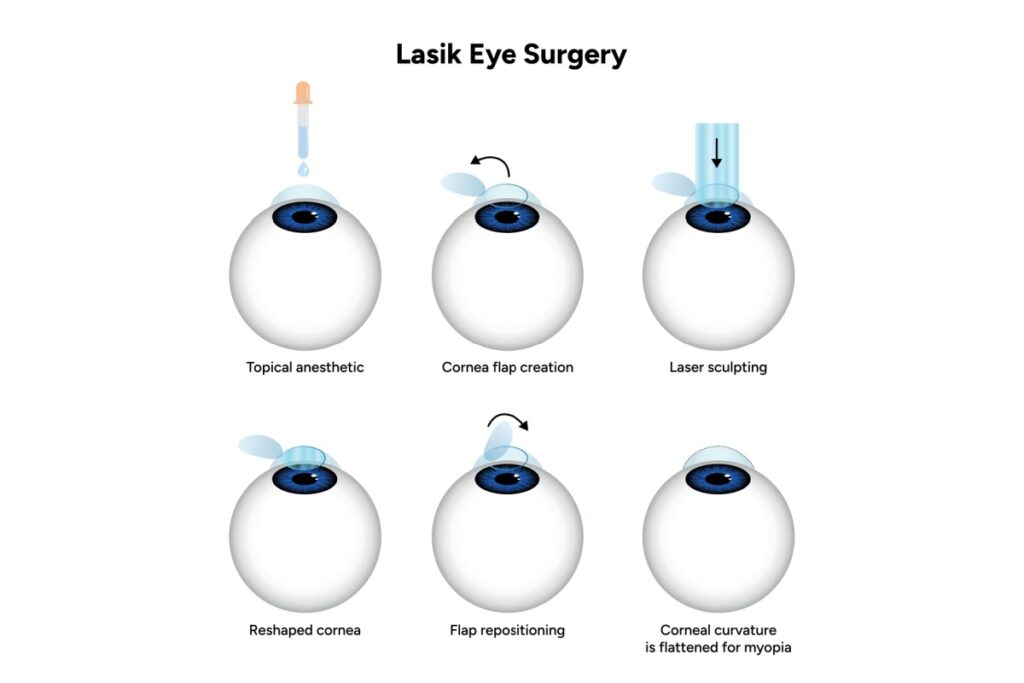Many people with astigmatism wonder if LASIK surgery can help them see clearly without glasses or contacts. You might have been told that your irregular cornea makes vision correction more complicated than simple nearsightedness or farsightedness. At Northern Lights Eyecare, we help patients understand their laser eye surgery options through comprehensive consultations.
LASIK can effectively correct most types of astigmatism by reshaping your cornea to help light focus properly on your retina. The success of your treatment depends on several factors, including the type and degree of astigmatism you have, plus your overall eye health.
What Astigmatism Does to Your Vision
How Your Eye Shape Affects What You See
Your cornea normally has a smooth, round curve like a basketball. With astigmatism, your cornea has an irregular shape that’s more like a football, steeper in one direction than the other.
This uneven shape causes light to focus at multiple points instead of one clear point on your retina. The result is blurry or distorted vision that affects how you see both near and far objects.
Common Signs You Might Have Astigmatism
- Blurred or distorted vision at all distances
- Eye strain and headaches
- Difficulty seeing at night
- Squinting to see clearly
How LASIK Works for Astigmatism
The Laser Reshaping Process
LASIK corrects astigmatism by using a precise laser to reshape the uneven areas of your cornea. The laser eye surgery procedure removes microscopic amounts of tissue to create a more symmetrical, round surface.
Unlike treating simple nearsightedness, astigmatism correction requires the laser to work on different areas of your cornea with varying intensities. This creates a more uniform shape that helps light focus correctly.
Types of Astigmatism LASIK Can Address
Regular astigmatism, where your cornea has a consistent oval shape, responds well to LASIK treatment. This is the most common type and typically achieves excellent results.
Irregular astigmatism, caused by corneal scarring or disease, can be more challenging to treat. Your surgeon needs to carefully evaluate whether LASIK is appropriate for your specific situation.
LASIK can typically correct astigmatism up to about 5-6 diopters, though lower amounts generally have more predictable outcomes.

Who Makes a Good LASIK Candidate with Astigmatism
Eye Health Requirements
Your prescription needs to be stable for at least 12 months before surgery. Changing prescriptions indicate your eyes are still developing, which can affect your results.
You need adequate corneal thickness to allow safe tissue removal during the reshaping process. Too thin corneas increase the risk of complications. Corneal topography testing helps determine if your cornea structure is suitable for LASIK.
Healthy eyes without active infections, severe dry eye, or progressive diseases like keratoconus are necessary for successful treatment.
Astigmatism Degree Considerations
Mild to moderate astigmatism (up to about 3 diopters) typically has high success rates with LASIK. Most patients achieve 20/20 vision after treatment.
High astigmatism may require alternative treatments like PRK or implantable lenses, depending on your corneal characteristics and overall eye health.
What to Expect During Your LASIK Consultation in Prince Albert
Comprehensive Eye Measurements
We evaluate your refractive error, corneal health, and tear film quality, as these factors can influence your surgical outcomes and recovery. Dry eye testing is particularly important since healthy tear production supports proper healing.
Discussion of Your Treatment Options
Your consultation includes a thorough review of whether LASIK is right for your specific type and degree of astigmatism. We explain what results you can realistically expect.
If LASIK isn’t suitable, we discuss alternative options like PRK, implantable contact lenses, refractive lens exchange or continuing with glasses and contacts until better treatments become available.
Recovery & Results After LASIK for Astigmatism
First Few Days After Surgery
Most patients notice clearer vision within 24-48 hours, though your eyes continue healing for several weeks. Some fluctuation in vision clarity is normal during this time.
You’ll need to avoid rubbing your eyes, swimming, and strenuous activities for about a week. Eye drops help keep your eyes comfortable and prevent infection.
Long-term Vision Outcomes
LASIK can significantly reduce or eliminate your dependence on glasses and contacts for most daily activities. Some patients may still need reading glasses as they age or glasses for night driving.
Regular follow-up visits help monitor your healing and ensure your cornea maintains its new shape. Most patients achieve stable vision within 3-6 months.
At Northern Lights Eyecare, we help you explore whether LASIK is right for your astigmatism through comprehensive consultations and honest discussions about your options. Contact our Prince Albert eye clinic today to schedule your LASIK consultation and take the first step toward clearer vision.


